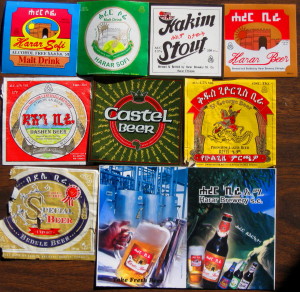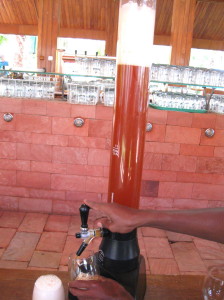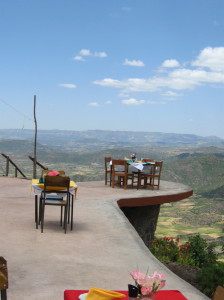For a country with a significant Muslim population, Ethiopian beer is very available and inexpensive.
Our beer adventure started in the capital Addis Ababa. Saint George (the dragon killer) is the patron
saint of Ethiopia and the name of the most popular brand of beer (mostly available in 33cl bottles).
Much to my disappointment -- no cans. (So, another paper label for my collection of cans from 'countries
I've been to'. I have over 90 and could use another 20.)
The cost of a bottle in a bar or restaurant is always less than a dollar. The exchange rate is 17 birr
to a U.S. dollar. The most common price was 12 birr. Since the bottle deposit is very high, we decided
to stick to the bars, which had a lot more local color and our rooms were pretty dingy, anyway. Our first round
was at our hotel, the Itegue Taitu (a former empress), the oldest hotel in Addis. Onto GB's London Cafe;
beer was only 10. But, when we looked at the bill, it turned out to include a 10% service charge and 15% vat.
What gripes me is that they applied the tax to the service charge, so the total is 26.5%. I know it's still
cheap, but I don't like the government getting an extra slice.
Next stop was the "no name." It had a name but we couldn't read the Ethiopian letters. The Amharic language uses an alphabet
something like hieroglyphics. When we ordered, the waiter asked "jumbo?" How could we say no. So we were
soon served 16 oz. draft beers and they were only 11 birr. Smart move. On a trip to the men's room I entered
a room just big enough for a snooker table. It was surrounded by about 20 guys, no pool cues, but several
red and white snooker balls and one white and one red pushpins stuck in the center of the table. It
appeared to be total chaos, yet the game went on. It's called Carambula and was introduced by the Italians
{more}. We enjoyed the first beer so much we decided to have another.
This time we asked if the bar had anything else (bad move). The waiter said yes, but that would be 15 birr. What the
heck, it should be special at that price. Nope, bottled St. George's. Can't win them all. For dinner, back
at the Taitu, we had Dashen beer with our meal, which is brewed in Gonder.
First day out on our private tour, we passed some young ladies holding up bottles of clear and amber liquid.
We asked our driver, Woldegbrail, what it was and he said alcohol. "Let's stop," we chorused. The first young lady offered a
clear bottle through the window. I sniffed it and it smelled like alcohol all right. The amber bottle smelled
like grappa and probably tasted worse. She wanted 50 birr for a one liter bottle. We weren't interested but
then about 10 bottles from other vendors were being jammed through the open window. Gabriel, as we called him, pulled away
as the price quickly dropped to 20 birr. A real bargain; it probably would have killed us.
At our destination on Lake Tana we ordered Meta beer, which at 4.5%, was alright; however, the waiter
told me that it used to be ladies' beer. Enough of that, I ordered a Bedele beer from the town of the
same name. At 5.5% and coming in a 500ml bottle at the same price as the 330ml beers. It became my new
favorite. Little did I know I would never get another. We wouldn't be going to Bedele, which was a
shame since the guide book said they did brewery tours. Not to worry, we would quickly make up for
that. As we arrived in Gonder, one of the ancient capitals we would visit, we passed the Dashen Brewery.
We had already drunk some of their beer, but the large WELCOME sign at the brewery gate got my attention.
After completing our tour of several palaces and a royal bath which is still used to perform mass
baptisims, the guide asked do you wish to see the royal compound? Much to our driver's surprise,
I said, "no, we wish to go to the brewery." Gabriel hesitated and was about to say, "That's not in the
program," when our guide Solomon said, "Oh, that's very nice, I used to work there." Solomon stayed
behind, he had more guide duty to perform. We proceeded to the brewery. After the usual security
hassle, the driver brought the Land Cruiser in and was frisked. Then we proceeded to a beautiful
outside beer garden. One thing about being white people in Ethiopia, you get noticed. A young man
asked us if he could help us. So we asked about a tour. He said he would arrange it, but it would
take a while.
We went to the bar to while away some time and ordered three mugs of draft beer. Gabriel had gotten
with our program. The beer was unfiltered and unpasteurized, and is served only at the brewery within
24 hours of brewing. We also had a great hamburger. Of course, none of this was free, but it was
pretty cheap. It did take awhile, but the tour finally commenced. The first guide didn't speak English,
so Gabriel had to translate. As part of the tour the guide gave us some malt to taste. This was nothing
new to us, but Gabriel, a little leery, took a taste and was sold. He must have reached into the sack
for more because he was chewing the barley throughout the tour. The tour was quite extensive -- we
were in the only computer-controlled brewery in Ethiopia. We eventually got an English speaking
guide who even gave us a tour of the waste water treatment facility. As the tour ended the guide
announce that, "Each guest to The Dashen Brewery was entitled to two beers." All right! We can handle
this. He took us into another outdoor bar and then spoke to the waitress, who then departed. Being
very thirsty (brewery tours have that effect) I wondered why she left since the taps at the bar
seemed serviceable. When she returned, I was shocked. She was carrying a tall clear cylinder full
of beer with a tap on the bottom. Our guide began filling glasses from the three-liter container.
When the level in the container sank about half way the waitress placed a slender tube filled with
ice cubes into the beer tower. Have no fear, there is a photo of this invention above. Who says
Ethiopia is a backward country. What a great beer experience.
During our visit to Axum one of the ancient capitals and home to some magnificent stelae, we paused
at a bar painted in the Saint George's yellow and red colors. It proclaimed to be a draft house. As
a waitress passed by, we asked, "Do you have draft beer?" She never slowed down leaving us to wonder if
she had heard us. In record time she returned with two foamy mugs. Life is good.
A few days later, we were in Kombolcha, home of one of St. George's three breweries. Saint George's
produces 85% of Ethiopia's beer plus exports. We waited at the gate awhile as Gabriel pleaded our case
for a tour. Finally, we were escorted into the manager's office. He plainly didn't like us being there.
This was not the main brewery and they had no PR department. He did ask us if we wanted a beer, so we
said, "of course" and a guy in a worker's smock brought in two bottles of Saint George's with no glasses.
I hate drinking beer directly from a bottle and have been fighting a losing campaign to convince people
to use a glass. The manager wasn't happy when I asked for a glass but he summoned the same guy and he
eventually returned with what had to be a freshly rinsed water glass. I gave it to my wife and
reluctantly continued to suck the beer from the bottle. Before we finished, the manager announced
that the tour would commence. As we stood to leave the guy in the smock returned with two brewery
labeled pilsner glasses. They stayed in the office.
The tour was conducted by one of the guys from the lab. It was an excellent tour and afterwards he
took us to what was supposed to be the brewery tap. The manager there was even less thrilled than
the first guy. He told us to have a seat and instructed his secretary (who probably wasn't hired for
her typing ability) to get us a beer. She gave us a choice and we ordered Castle, the premium brew.
Once again no glasses. But at least this time Gabriel got a beer. Hospitality was not on the menu,
so I was glad I swiped a couple labels during the tour.
The next day, we stopped at the Harar Brewery in the town of the same name. We were told we were
too late and to come back tomorrow It might have been too late for a tour but not a beer. The brewery
tap is open to the public, so before leaving we stopped in. I bravely ordered a Hakim stout. I was a
little leery, because other stouts I've had in Africa have been very sweet. This one wasn't and my wife
decided to have one on the second round. Next day we returned for what was a very interesting and
beneficial tour. We were asked to don smocks and, looking like a group of mad scientists, followed
one of the managers into the brewery. First stop was a wall-plaque which stated, "As an act of
communist brotherhood, The Pilsen brewery from Czech.... constructed this brewery in 1984." Some of
the locals, including our guide, went to Pilsen to learn brewery operations. In 1991 Ethiopia kicked
out the commies but kept the brewery. What a deal.
During the tour we learned that the brewery produced three by-products: spent grain, which they sell
to farmers as animal feed; CO2, which they bottle for their draft beer, selling the extra to soft drink
bottlers; and yeast, they are still using the original strain from 1984. The rest of the tour was pretty
standard. As the tour wound down I asked the guide if we could have some labels or calendars as souvenirs.
I especially wanted a calendar because Ethiopia is about 7 years behind the rest of us and I was interested
in studying one. The guide said to wait here and left, returning with a hand full of labels from each of
the four different beers they produce: Harrar Beer, Hochim Stout, Sofi alcohol free malt beverage and
Sofi lemon flavor alcohol free malt drink (for Muslims). Gabriel said, "I thought you wanted a calendar?"
"I did, but I wanted to get something so as not to leave empty-handed." We returned to the guide's office and
he asked us to sign their visitors' log. As we did so, he asked my wife if he could have her pen. I guess
he wanted to get something out of the deal. When I saw which pen it was I pointed out that a beer can
collector friend of ours had provided it as a souvenir of a beer can collectors' meeting we had attended.
This seemed to impress him and he reached into his desk and produced a hand full of pocket calendars
and then pulled some wall calenders from a box. He offered us one a piece but I said one for Gabriel
and one for us was enough. So I got more than I hoped for. It was too early for a beer at the brewery,
but we had plenty later that day in town.
Our last beer event was at the Garden Brau brewpub near the Bole International Airport in Addis Ababa.
It was a German operation and the prices were many times higher than the rest of Ethiopia. Being the
celebration of the end of our journey, we treated Gabriel to lunch and we shared another 3-liter beer
tower. The beer of course was very different from the local brews. We had a dark lager and along with
some bratwurst we had our own little Octoberfest.
Besides beer, we encountered some other Ethiopian alcoholic beverages. Tella is brewed from various
grains, typically maize and teff (teff is a grasslike grain which is to Ethiopia as wheat is to North
America). Barley, millet or sorghum may be used as well, and gesho, a local plant similar to shiny
blackthorn, is used in place of hops. It is normally made for holidays and is fermented in the
kitchen -- real home brew. We had some at the most outlandish restaurant just outside Lalibela.
A Scots woman named Susan is creating the Ben Abeba. (Ben is Scots for mountain and Abeba is Ethiopian
for flowers.) The glass of tella was rather inoffensive. She also served us Tej, which is honey wine,
flavored with powdered leaves and twigs of gesho. It was a lot nicer. There are Tej bars in some areas.
Also, it's not uncommon to round off your meal with a cup of shybuna, a mixture of tea and coffee. Gabriel's
favorite.
 BACK to "Beer Reports"
BACK to "Beer Reports"
 BACK to "Beer Reports"
BACK to "Beer Reports"


